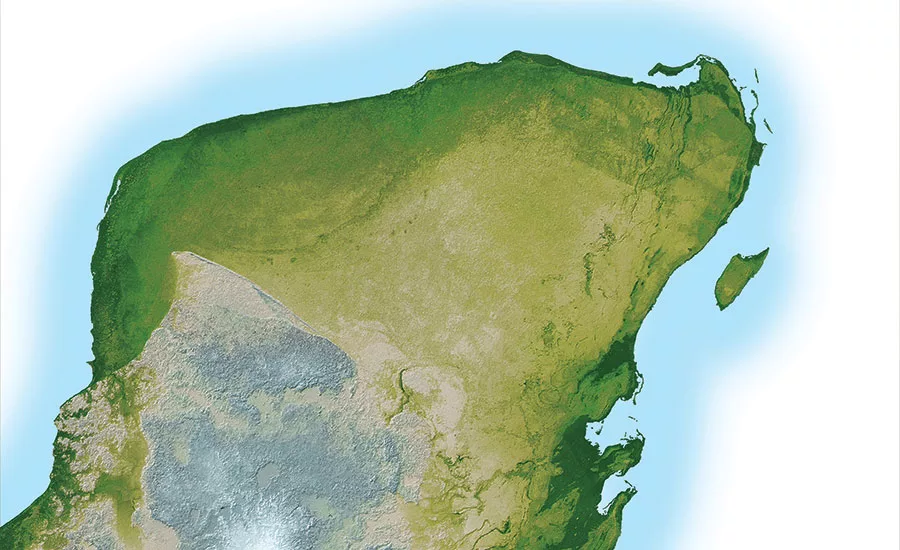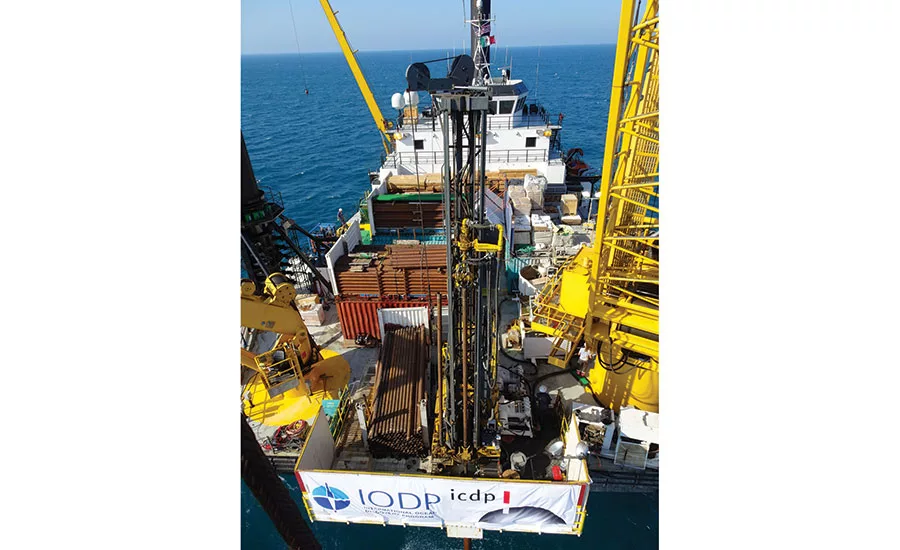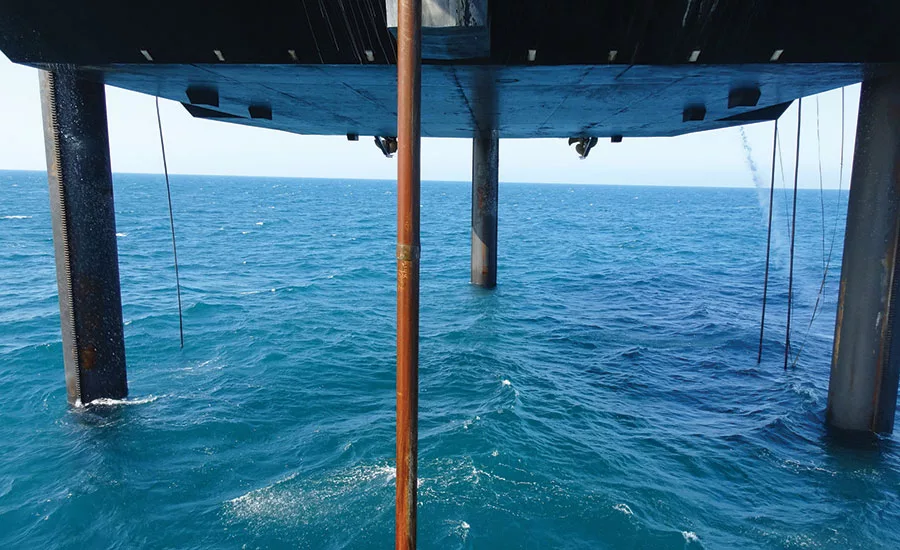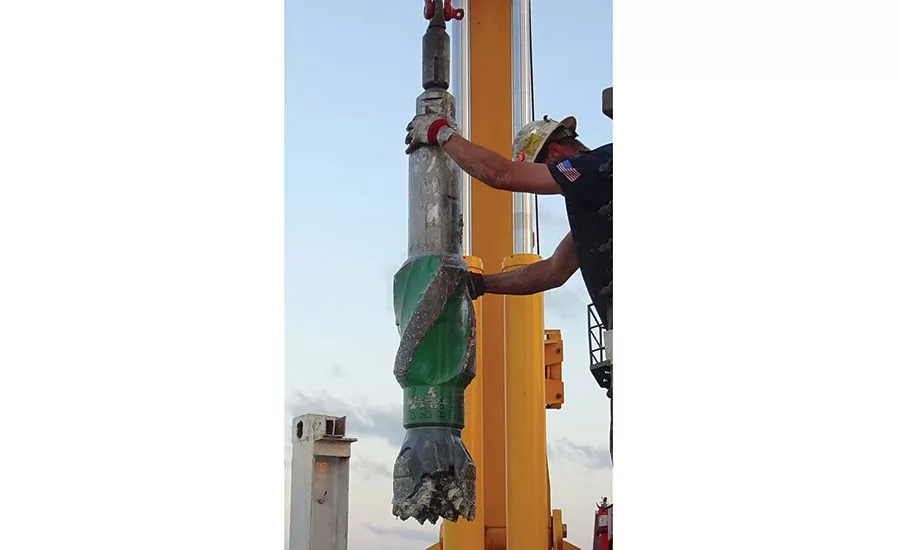Drilling for Answers to Dinosaur Demise

This shaded relief image of Mexico’s Yucatan Peninsula shows a subtle indication of the Chicxulub impact crater. It highlights a semicircular trough, the darker green arcing line at the upper left corner of the peninsula. The trough is about 3 to 5 meters deep and 5 kilometers wide, according to NASA. Source: NASA/JPL

DOSECC Exploration Services, based in Salt Lake City, recently completed an offshore drilling project obtaining core samples of the Chicxulub impact crater, thought to be responsible for dinosaur mass extinction. Source: European Consortium for Ocean Research Drilling

An Atlas Copco T3WDH drilling rig, was mounted on a liftboat jacked above the ocean about 30 kilometers northwest of Progreso, Yucatan in Mexico. Source: European Consortium for Ocean Research Drilling photos

Crews accomplished 100-percent core recovery and drilled a total of 1,334.69 meters below seafloor.
Around 66 million years ago, a massive asteroid struck Earth in the area now known as Mexico’s Yucatan Peninsula. Many scientists believe that the impact of the asteroid, which resulted in a crater named Chicxulub after a village near the epicenter, led to a mass extinction that included dinosaurs.
Scientists have spent many years researching the crater and today, drilling is playing a key role in helping deliver solid answers. The International Ocean Discovery Program’s (IODP) Expedition 364 aims to address several questions related to the Chicxulub impact crater by drilling into the structure to recover cores from and above the peak ring.
Joanna Morgan, professor of geophysics at Imperial College London and co-chief scientist of Expedition 364, says this is a first-of-its-kind drilling project in that there are no other known intact peak rings on the globe and this is the first time one is being drilled into. She describes the peak ring as a ring of hills inside the crater, highlighting that the Chicxulub crater is the most pristine large crater known of on the planet.
“You can do geophysics, map the area and try to work out the model for how something would happen,” says Dave Smith IODP-ESO operations manager. “But it’s only by calibrating that seismic or geophysical data that you can really understand exactly what it is. That’s taking physical material out of the ground and actually working with it. … The core is by far the primary information that’s gathered.”
Morgan echoes Smith’s opinion about the significance of core drilling for Chicxulub crater research.
“Because it’s buried beneath the surface, at the moment what we’re relying on is geophysical data. So we use seismic reflection and refraction data and we study the crater. We’ve got images of it. … We can see a beautiful peak ring, but we can’t say what rocks this peak ring is made of. So the value of drilling is to actually get a physical sample.”
Drilling from a Liftboat
The offshore drilling phase of the project officially kicked off April 5, when the ECORD Science Operator (ESO) team sailed from Progreso, Yucatan in Mexico to an offshore spot approximately 30 kilometers northwest. The initial goal was to drill and core a 1,500-meter-deep borehole from L/B Myrtle, a liftboat jacked up above 17-meter-deep water.
DOSECC Exploration Services, headquartered in Salt Lake City, was contracted to take on the drilling aspect of the project. In addition to geothermal, geotechnical and mining, the company specializes in scientific endeavors. Chris Delahunty, director of operations for DOSECC Exploration Services, says that while they are no stranger to teaming with the scientific community, drilling in this format is pretty unusual.
“This isn’t a place you can just run a truck right into and get a delivery any time you want...Logistically moving things from the shore to the boat takes time and effort.”
“This is only the second time we’ve ever drilled on a liftboat. … So it’s fairly atypical for us to drill in the ocean on this type of a platform. … Only very rarely do we get to go out into the ocean and drill. So this is a pretty unique, interesting project with lots of interested people, and being a drilling contractor kind of in the middle of the action here has really been a phenomenal experience.”
Going into the project, Delahunty points out that careful planning was critical. It was important that they fit the proper equipment to the job to make sure they would be able to successfully circulate the hole and remove cuttings once offshore.
“This isn’t a place you can just run a truck right into and get a delivery any time you want,” he says. “Logistically moving things from the shore to the boat takes time and effort. So in terms of planning, a lot of forethought goes into making sure that we have as much out here as we possibly can, and then to be able to project a week or two in advance if you can for things you might need so they’re arriving in the time that you need them. … So logistically it’s got a fair set of challenges.”
Once on the platform, they had to make the most of the cramped 100-foot-long-by-50-foot-wide jobsite. Delahunty says they were carrying about 10 different tubular sizes on an order of 1,500 meters worth of depth capacity, so they had to stack them on flat racks to keep them organized. He says that typically, a drilling rig of the size they were using and the tools to accompany it would be spread over a much larger jobsite on land.
“If I’m going to change rods, I can’t just back a trailer up at the front of the drill and start drilling with a different rod,” he says. “The crane has to lift one flat rack out of the way. Another flat rack has to be lifted in place. We’re actually pulling our rods off of the helper’s side, parallel with the rig to the side of the drill rig. So we’re actually bending these rods around the front of the drill, which is laid on the platform, but the head is actually on the outside of the boat edge so the head can travel down.”
The beneficial side to being on a liftboat is that they were above the water and removed from its effects. Because the platform stood on three legs with pads, hardly touching the seabed, and the mud was recycled instead of dumped into the water, their environmental footprint was quite small, Smith says.
Continuous Coring
The DOSECC Exploration Services crew consisted of a driller, offside helper and mud man, in addition to a floating employee, motor man, Delahunty and an onshore teammate helping expedite parts and pieces they needed as they drilled. They ran two 12-hour shifts a day; one midnight to midday and the other midday to midnight.
The borehole was drilled using an Atlas Copco T3WDH. Delahunty says the deep-hole model offers 70,000 pounds of pullback. Originally a rotary drill, it was modified to deliver higher rpm for core work. They used a diamond wireline coring technique.
“So we’re basically adding rods at 6.1 meters per span and then doing 3.05-meter runs,” Delahunty says. “Then using a wireline to run in a gravity inner core barrel and then free it to the surface with the core inside.”
As of May 18, when Delahunty and Smith spoke with National Driller, the borehole had reached 1,043 meters below seafloor with a diameter of 4.9 inches.
They used a continuous coring method, but not right from the surface. The geology most relevant to scientists doesn’t start until around 500 meters below seafloor since the crater is buried, so the crew open-hole drilled to 505.7 meters and set the casings.
“Instead of rotary for a certain distance and then taking spot cores as some groups would do in order to save money, we basically started at that 500 meters and every 10 feet, it’s a 10-foot core run. The core comes to the surface, you send the tool back to the bottom and you get the next 10 feet. So we are back to back to back to back cores right now down to 1,043 meters in that fashion,” Delahunty says.
Over the course of the past two days, he says they accomplished between 45 and 50 meters of core every 24 hours. With regard to formation, he says the borehole was stable and in an area free from a lot of tectonic action and fractures.
As for geology, Smith says they encountered carbonate first, formed a long time after the meteor hit; then an area of ruptured rocks called impact breccia, which started fine and became more coarse with depth; then impact melt rocks and granite. He says the rocks would have melted from the energy in the meteorite, and is now hard, black, brittle material.
The experience wasn’t without typical drilling setbacks. Bits were worn out, so they had to trip out and change them. They encountered problems with casing downhole and lost circulation. But the challenges were well worth it in the end.
“What we’re most pleased about is the quality of the core that’s coming out of the hole and the fact that we are at near 100-percent recovery, which means we’re not leaving very much, if anything, behind to guess work. They’ll have all of the core out and make good conjectures based on continuity,” Delahunty says.
100-Percent Completion
As of May 31, the offshore drilling phase of Expedition 364 had been completed, with 100-percent recovery. The 55-day project accomplished a drilled depth of 1,334.69 meters. A total of 828.99 meters was cored. A total of 303 cores, 830 sections and 1,075 samples were obtained. The crew used eight core bits in all.
The onshore science phase is expected to start Sept. 21 and last for a maximum of four weeks at the IODP Bremen Core Repository in Germany.
Both Smith and Delahunty say they are very pleased with the expedition, from both a drilling and scientific standpoint, highlighting that it was a long time coming, as are many scientific undertakings.
Unlike most commercial contracts, which typically take a few months to a year of planning, scientific jobs in unusual locations with unique demands tend to require a lot more logistical oversight.
“The longest project I ever hung out on was an eight-year lead time in order to get it going. We supplied information for eight years until it finally developed, but these are the projects that are of interest. This is trying to understand Earth’s process, how it all came together, and basically the history and past of the world,” Delahunty says.
For scientists, the project phase can be even farther out, Smith says.
“These scientists put a proposal in and it could be 10 or 15 years. … So to get through the system that we have is a long process for them and many projects never get funded. For them, it’s a huge relief to be here.”
In addition to fostering a better understanding of the crater’s earthly history and implications, Smith says findings from the core samples could potentially help researchers extrapolate to what happens on other planets. He expects very high-profile scientific papers to result from the drilled data.
“There are not many people who are going to even attempt this because the risks are high and the rewards maybe not so much. But this is really something that we at DOSECC Exploration Services are really excited about and really try to be a part of because it is a different feeling than your standard commercial drilling,” Delahunty says.
Looking for a reprint of this article?
From high-res PDFs to custom plaques, order your copy today!




